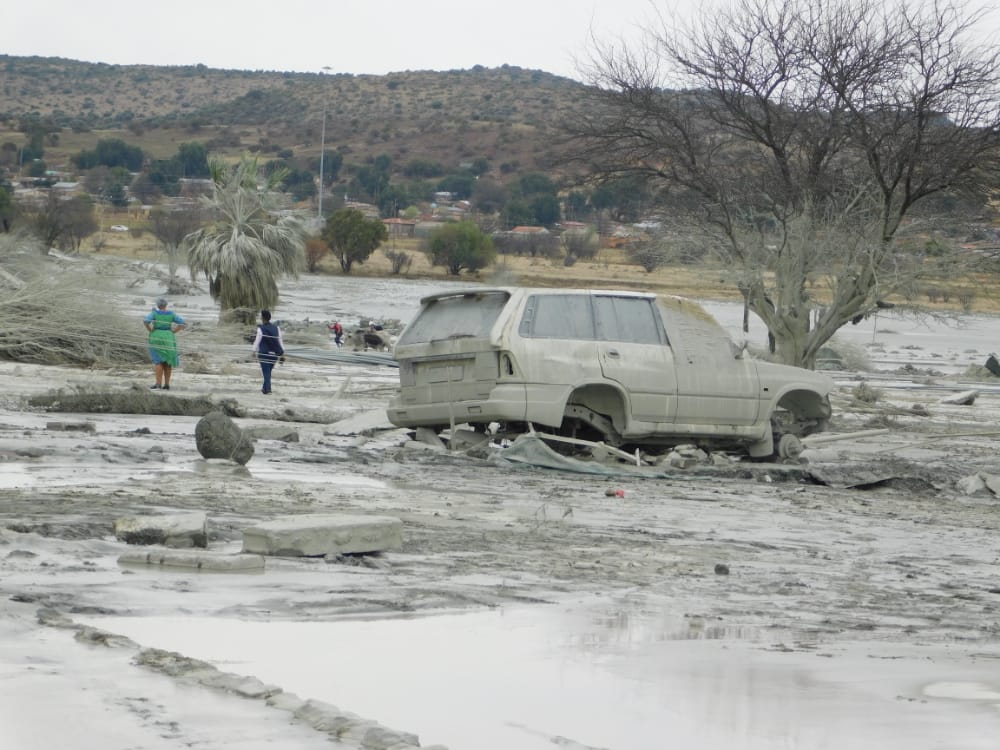The race is on to restore South Africa’s mining industry’s reputation among global critics of an industry largely associated with deplorable environmental management practices. On Monday, President Cyril Ramaphosa paid a visit to the Jagersfontein mine in the Free State, followed by Mineral Resources and Energy Minister Gwede Mantashe and his deputy minister the very next day.
It was the 9/11 of the South African mining industry; some bravely refer to Jagersfontein as the new “Marikana” of a mining industry that preaches great operational efficiencies but consistently falls short when the chips are down.
The first dam burst occurred around 02:00 on September 11, 2022, with little emergency relief effort initiated. Within the next two hours, multiple breaches of the tailings dam collapsed, dumping all of the chemical slime into the sleeping town of Jagersfontein. An avalanche of white slime invaded their sleeping quarters, homes, and washed away cars, killing three community members and leaving over 300 homeless.
It was on that morning that the vast legislative frameworks that oversee mining : The much heralded Minerals and Petroleum Resources Development Act (MPDRA) under DMRE , National Environmental Management Act (NEMA) under the Department of Mineral Resources (now called the Department of Mineral Resources and Energy, DMRE) and the Department of Environment, Forestry and Fisheries, (DEFF) waded into deeper waters of ruthless scrutiny amongst human rights lawyers, investors, impact reporting specialists and no lesser a person than South Africa’s head of state.
By the middle of the week the inquest and the sniping blame game was in full swing. Legal practitioners dusted previous case laws and the Minister Gwede Mantashe conceded his department has been elbowed from regulating tailings by the ruling of DE BEERS CONSOLIDATED MINES LTD v ATAQUA MINING (PTY) LTD & OTHERS (Case No. 3215/06, Orange Free State Provincial Division, 13 December 2007, in which case the “court held that tailings dumps are movables and as such ownership vests in the person who removed the minerals as they had occurred naturally in or on the earth.
It held further that the Mineral and Petroleum Resources Development Act 28 of 2002 (MPRDA) did not take away such ownership and did not control tailings dumps created before the MPRDA commenced”. Mantashe flatly rebuked this ruling, which he said fragmented the mining value chain.
Aside from the legal battles over who will carry the ultimate can and be punished, two factors would stand out: in the shares transactions effected by the various transactions of the mine (governed by Section 11 of the MPRDA), what were the submissions pertaining to the EIA and EMP submitted for the tailings; and what political interference occurred to mollycoddle liability for the multiple failings flagged by researchers in the years preceding the disaster?
The murky Section 11
Stargems Group, a Dubai-based diamond trading company that took over the De Beers-owned mine in 2010 (giving effect to the MPRDA Section 11 shares transfer) is reported as saying they conducted a “full due diligence prior to this acquisition showing that the assets, including the dam were safe and secure”. We are yet to learn of the quality of the due diligence and the EMP in place as part of the exhaustive process that convinced the DMRE Minister to approve Section 11.
What we now know is that Stargems did not take full ownership, as Rupert’s Reinet Investments stayed on as a lead shareholder in the Jagersfontein diamond property until April this year. Which would imply that the Section 11 requirements remained the prerogative of the two shareholders, who were invested throughout the period of degradation of the tailings. After all, Stargems, according to their website, are a “Wholesaler, Preparer, polished manufacturer and Retailer”, technically an admission that they are a specialist trading and marketing company on behalf of miners and would as such not be involved in operational issues at the sites, including Jaggersfonetin.
The perplexing part is that Stargems lists De Beers as part of their group on their website, which could imply that De Beers did not completely exit the operation, but rather passed it on to a subsidiary.
This week, social media was flooded with videos of submissions to the Zondo Commission accusing Free State political leaders of interfering with mine license approvals. While the nation awaits a full investigation into the cause of the dam collapse, Phosa Loots Attorneys was filing a class action lawsuit on behalf of families affected by the loss of life and property.
As the dust settles, Jagersfontein could serve as a platform for the National Government to create a task force to police the legacy mining infrastructure that has resulted in the ongoing zamazamas crisis. The country could lose billions of dollars in investment if we are seen to harbour investor multinationals who have close ties to criminal networks; this undermines the fundamental requirements of investment: the rule of law. Their noncompliance is comparable to that of the zamazamas who short-circuit the MPRDA for profit.
Opinion by Editor Fulufhelo-Lloyd Nedohe
info@esgfrontiers.co.za












